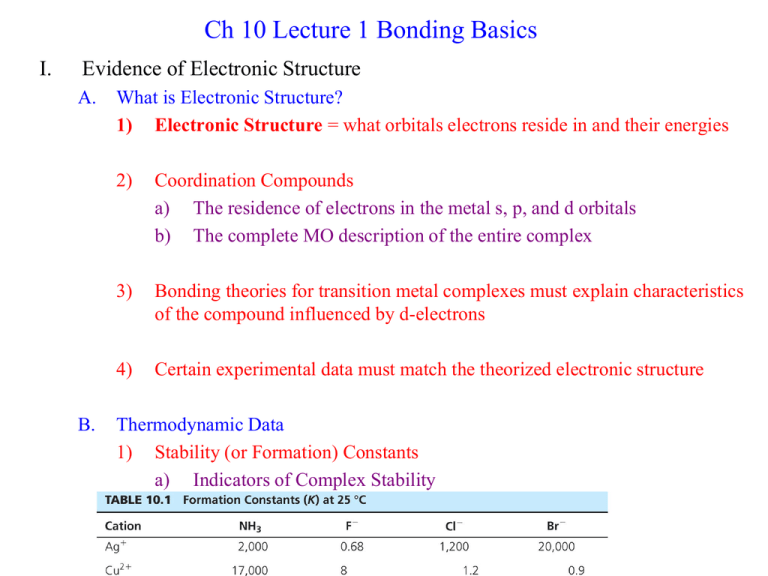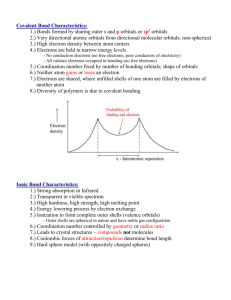Chapter 1 Structure and Bonding
advertisement

Ch 10 Lecture 1 Bonding Basics I. Evidence of Electronic Structure A. B. What is Electronic Structure? 1) Electronic Structure = what orbitals electrons reside in and their energies 2) Coordination Compounds a) The residence of electrons in the metal s, p, and d orbitals b) The complete MO description of the entire complex 3) Bonding theories for transition metal complexes must explain characteristics of the compound influenced by d-electrons 4) Certain experimental data must match the theorized electronic structure Thermodynamic Data 1) Stability (or Formation) Constants a) Indicators of Complex Stability b) Cu2+ Equilibrium constants of complex formation )2+] + NH3 [Cu(NH3)]2+ [Cu(NH3 + NH3 [Cu(NH3)2]2+ + NH3 [Cu(NH3)3]2+ + NH3 [Cu(NH 3 )]2 4 K1 1.7 x 10 [Cu 2 ][NH 3 ] [Cu(NH3)2]2+ [Cu(NH 3 ) 2 ]2 3 K2 3.2 x 10 [Cu(NH 3 ) 2 ][NH 3 ] [Cu(NH3)3]2+ [Cu(NH 3 )3 ]2 2 K3 8.3 x 10 2 [Cu(NH 3 ) 2 ][NH 3 ] [Cu(NH3)4]2+ [Cu(NH 3 ) 4 ]2 2 K4 1.5 x 10 2 [Cu(NH 3 )3 ][NH 3 ] c) Combining the individual steps gives the overall stability constant b4 b4 = K1 x K2 x K3 x K4 = 6.8 x 1012 d) e) Large b values indicate favorable reactions and/or stable complexes Small b values indicate unfavorable reactions and/or unstable complexes f) 2) Can be measured by pH titrations, UV-Vis titrations, etc… Thermodynamic Data a) DG = -RTlnK = DH – TDS allows calculation of free energy, entropy, and enthalpy of a reaction from stability constants b) These values can help explain bonding in coordination compounds, but detailed theoretical calculations are needed to fully rationalize a given set of data c) Most useful to see differences in a single parameter in a series of related compounds d) Example: DH might decrease from Br- to Cl- to F- for their complexation to Fe3+ (Hard-Hard Interaction) e) This data is not very useful in predicting structure or bonding interactions of coordination compounds in general C. Magnetic Susceptibility 1) Magnetic Properties reveal numbers of unpaired electrons 2) Hund’s Rule requires maximum number of unpaired electrons in degenerate orbitals not 3) Magnetic Descriptions a) Diamagnetic = all paired electrons = slightly repelled by magnetic field b) Paramagnetic = unpaired electrons = strongly attracted by magnetic field 4) Magnetic properties are determined by one of several experimental methods 5) Molar Magnetic Susceptibility = cM = cm3/mol = data from an experimental determination 6) Magnetic Moment = Calculated value from cM and theoretical treatment of magnetism. m = 2.828(cMT)½ Bohr magnetons 7) Theoretical basis of magnetism a) Electron Spin: a spinning charged particle would generate a spin magnetic moment = mS (not really spinning but a property of an electron) b) mS = + ½ or – ½ only because the electron can either “spin” clockwise or counter clockwise (up or down arrows) c) S = Spin Quantum Number = S mS i. Example: S = 3(+ ½ ) = 3/2 ii. Example: S = +1/2 d) Angular momentum quantum number = l = describes the orbital shape s = 0, p = 1, d = 2, f = 3 e) mL = Orbital Angular Momentum = + l, l -1,…..- l i. Each number is assigned to one orbital of the set ii. Example: p-orbitals +1 0 -1 f) L = Orbital Quantum Number = S mL i. Example: L = +1 + 0 + -1 = 0 ii. Example: L = 2(+1) + 0 = 2 g) Magnetic moment m depends on both S and L mS+L = g[S(S+1) + ¼ L(L+1)]½ g = gyromagnetic ratio ~ 2.00 for an electron h) The Orbital contribution is small for first row transition metals, so we can use a spin only magnetic moment = mS = g[S(S+1)]½ = [n(n+2)]½ n = number of unpaired electrons i) Example: calculate mS for high spin Fe3+ i. Determine d-electron count by counting back three positions on the periodic table (3+) and counting how far from left on the periodic table you are: d5 ii. Arrange the d-electrons in the 5 d-orbitals as high spin iii. Apply mS = g[S(S+1)]½ = 2[5/2(7/2)]½ = 5.92 Bohr magnetons Or [n(n+2)] ½ = [5(7)] ½ = (35) ½ = 5.92 II. Valence Bond Theory A. B. History 1) Proposed by Pauling in the 1930’s 2) Describes bonding using hybrid orbitals filled with e- pairs 3) Extension of Lewis/VSEPR to include d-orbitals Theory 1) Metal ions utilize d-orbitals in hybrids 2) Octahedral complexes require 6 hybrid orbitals a) d2sp3 hybridization of metal Atomic Orbitals provides new MO b) Ligand lone pairs fill the hybrid orbitals to produce the bond c) d-orbitals can come from 3d (low spin) or 4d (high spin) Fe3+ Co2+ 3) Problems with the theory a) High energy 4d orbitals are unlikely participants in bonding b) Doesn’t explain electronic spectra of transition metal complexes III. Crystal Field Theory A. History 1) Developed to describe metal ions in solid state crystals only 2) M+ is surrounded by A- “point charges” 3) Energies of the d-orbitals are “split” due to unequal geometric interactions with the point charges 4) Does not take into account covalency and molecular orbitals 5) Has been extended to do so in Ligand Field Theory B. Theory 1) Place degenerate set of 5 d-orbitals into an octahedral field of (-) charges (L:) 2) The electrons in the d-orbitals are repelled by the (-) charge of the ligands 3) The dz2 and dx2-y2 orbitals are most effected because their lobes point directly along x,y,z axes where the point charges are 4) The dxy, dxz, and dyz orbitals aren’t destabilized as much 5) The energy difference between these orbital sets is called “delta octahedral” = Do a) The low energy set has t2g symmetry and are stabilized by –0.4 Do each b) The high energy set has eg symmetry and are destabilized by +0.6 Do each c) The total energy of the 5 d-orbitals is the same as in the uniform field = 0 (2)(+0.6 Do) + (3)(-0.4 Do) = 0 6) CFSE = Crystal Field Stabilization Energy = how much energy is gained by the electrons in the 5 d-orbitals due to their splitting a) Co(III) = d6 low spin (6e-)(-0.4 Do) = -2.4 Do stabilization b) Cu(II) = d9 (6e-)(-0.4 Do) + (3e-)(+0.6 Do) = -0.6 Do stabilization c) Cu(I) = d10 (6e-)(-0.4 Do) + (4e-)(+0.6 Do) = 0 Do stabilization






